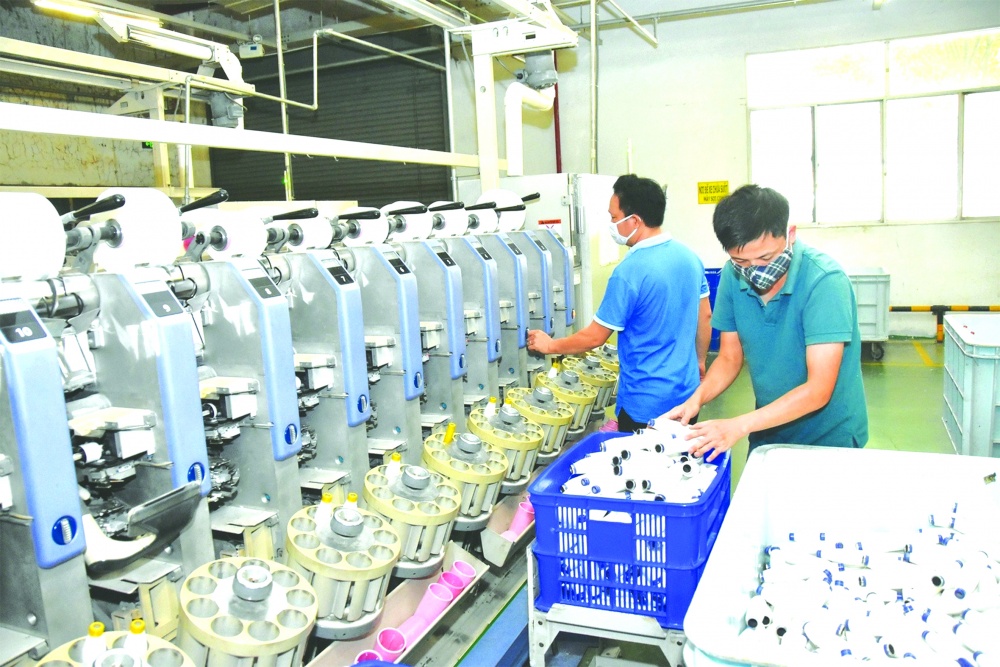Low capital absorption capacity of the economy
Of which, SME group credit grew by about 3%. According to Mr. Tran Anh Quy, credit growth is still lower than expected due to reduced credit demand and the economy's difficulty in absorbing capital.
Accordingly, the global economic downturn has caused businesses to lack orders for production. Meanwhile, production costs have increased, making it more difficult for businesses to reduce production and business; many businesses have had to postpone, stop, and convert production to deal with immediate difficulties. In addition, feasible business plans and the ability to convert production and business to adapt to market fluctuations of SME businesses are very limited. Mr. Tran Anh Quy acknowledged that because both domestic and foreign economies are facing difficulties, the level of risk is higher when businesses find it difficult to prove business efficiency. Meanwhile, credit institutions have difficulty lowering lending standards. This leads to credit institutions wanting to lend but not being able to find qualified customers.
Dr. Le Duy Binh, CEO of Economica Vietnam, also pointed out the risks of relying too much on credit. Accordingly, the total outstanding debt for the entire economy is currently around VND12.2 trillion, equivalent to about 125% of GDP. This is almost the highest level in ASEAN, much higher than OECD countries. "Therefore, we cannot raise the total outstanding debt of the economy too high. If we lend too much, it will harm the macro economy," Dr. Binh emphasized and said that if the above situation continues, Vietnam's economy will continue to depend too much on banks, going against all good international practices. The next problem is that all banks now have to raise standards such as meeting Basel II and Basel III. In addition to the requirements on capital safety and minimum capital levels, there are many other criteria such as credit quality. Therefore, the lending standards of banks will also have to be raised.
 |
| Cash flow management of many SMEs is still not transparent |
In addition, according to Dr. Le Duy Binh, the current management capacity and accounting system of SME enterprises still have many shortcomings and if the enterprise does not implement a clear accounting system, pay taxes, pay social insurance for employees, comply with legal regulations, good corporate governance principles, and there are always conflicts or internal disputes, then clearly the lender, the bank, will not be willing to lend money to this enterprise. "This is not the bank's money, but the money of the depositors at those banks. Therefore, the bank must be responsible to the depositors. Thus, it is clear that it is very necessary for the bank to maintain lending standards because it will protect both the interests of the depositors and society," Mr. Binh commented.
From the perspective of someone who works directly with businesses, Mr. Ngo Binh Nguyen - Director of SMEs OCB admitted that in Vietnam, cash flow management of SMEs is not transparent and there is still confusion between the financial stories of businesses and individuals. "They can use the cash flow of the business to serve some personal activities and vice versa. That lack of transparency leads to not seeing the real picture of the business. This creates a blurred point in the decision to grant credit to SMEs", Mr. Nguyen commented. Another major bottleneck that makes it difficult for this group of businesses to access capital is still an effective business plan. Collateral is also a limitation for businesses.
Expanding capital channels is an urgent problem.
Dr. Le Duy Binh assessed that banks play a very important role in providing capital for the economy. However, if we depend entirely on banks, it will create problems for a developing country and we will not be able to escape the trap called an economy that depends too much on banks (bank base economy). That has many potential risks for the safety of the banking system as well as the ability to meet medium and long-term capital of the economy. According to international practice, the ratio of short-term capital mobilized for long-term lending is often very low, while this ratio in Vietnam is very high. Recently, the State Bank has also taken steps to gradually reduce this ratio. In addition, the supply of medium and long-term capital by banks will have a certain limit, forcing businesses to seek other sources of capital. "We expect that in the near future, the bond market will continue to be more transparent so that businesses have a truly effective capital mobilization channel," said Mr. Binh.
Mr. Tran Anh Quy said that in the current financial development trend, expanding capital mobilization channels, especially through the stock and bond markets, are very urgent problems.
However, the recent stagnation of the bond market has greatly affected the capital mobilization of enterprises. Despite the difficulties, experts believe that this is still a very potential market for medium and long-term capital mobilization of Vietnamese enterprises in general, as well as Vietnamese SMEs in particular. According to Dr. Le Duy Binh, if there are good measures, legal mechanisms and a more favorable foundation, confidence in the bond market will certainly be restored. Enterprises with good and transparent issuance plans, with standards and closer supervision by the State Securities Commission, supervisory agencies, and depository agencies, will bring back investor confidence. "That is an opportunity for SMEs, especially medium-sized enterprises because they have the ability to provide information, information systems and the ability to issue bonds," said Mr. Le Duy Binh.
Dr. Nguyen Quoc Viet, Deputy Director of the Vietnam Institute for Economic and Policy Research (VEPR) Monetary policy has supported economic recovery.
The decision to reduce the operating interest rate for the fourth time since the beginning of 2023 by the State Bank of Vietnam has been carefully considered based on the actual situation when domestic inflation is well controlled, exchange rates remain stable, and the system's liquidity is abundant. With this move, the State Bank of Vietnam has sent a message to commercial banks to reduce the mobilization interest rate level, as a basis for reducing lending interest rates for businesses and people. It can be seen that, compared to the end of 2022 and the beginning of 2023, the lending interest rate level has now decreased. However, credit growth as announced by the State Bank is currently only 3.36%, relatively low compared to previous years. The reason is that the capital absorption capacity of enterprises is weak, difficulties are surrounding, causing enterprises to reduce orders, consumer demand both domestically and internationally has decreased, although the banking industry has implemented a series of policies to support the economy. However, it is clear that in order to recover and develop the economy, fiscal and monetary policies need to be coordinated very smoothly and in parallel. Accordingly, in the coming time, it is necessary to continue to implement fiscal policies more effectively, especially recovery support packages for the economy, targeting sectors with positive impacts. In addition, support policies must be simple, easy to implement, and targeted. Currently, support is often through reducing the collection of fees and charges and is being implemented in a scattered, ineffective manner that can cause budget waste. Therefore, the Government needs to narrow down the beneficiaries, targeting enterprises with high capacity and spread, focusing on two major difficulties for the business community today: supply chain disruption and increased production costs. Regarding monetary policy, it is necessary to maintain a state of "adaptation" to the current state of the economy with many risks; continue to balance financial risks with supporting economic recovery to facilitate capital flows. In addition to lowering operating interest rates in line with the domestic and international context, the regulation of money supply and ensuring liquidity of the SBV system, which has been quite good in the past, needs to be further promoted to ensure access to credit. Thereby, gradually improving credit growth of commercial banks in the remaining quarters of 2023. In addition, it is necessary to manage inflation expectations well, prepare contingency measures and act quickly and consistently if inflation risks are expected to increase gradually. Mr. Nguyen Van, Vice President of Hanoi Supporting Industry Enterprises Association (HANSIBA) Banks "symbiotically" with businesses
It can be seen that the business community is currently facing numerous difficulties. Through our members' understanding of the actual situation, we have realized that after more than two years of struggling and trying to maintain production and business activities that have been greatly affected by the Covid-19 pandemic, many businesses have had more difficulties due to broken supply chains, inventory, loss of partners, and recently, difficulties in power sources for production. In particular, small and medium-sized enterprises in the supporting industry sector need more attention in terms of policy mechanisms, production land infrastructure, and new technologies. Capital is like blood flowing in the human body. Only when blood circulates well can the body be truly healthy and develop. The same goes for businesses. When capital circulates well, their production and business activities will be smooth and effective. We share and agree with the State Bank's view that reducing interest rates is a constant desire of banks, businesses, the National Assembly, and the Government. However, reducing interest rates must be placed in the context of macroeconomic and monetary stability and ensuring the safety of the banking system. The stability and safe development of the banking system are also important partners in the development of businesses. Therefore, the State Bank's continued lowering of operating interest rates for the fourth time since the beginning of the year to create conditions for commercial banks to reduce lending interest rates to businesses in difficult times is extremely necessary at this time, specifically demonstrating the symbiotic relationship with businesses. In order for industrial enterprises to continue to recover, maintain all investment activities, and rebuild production and business systems, in addition to support from banks, there needs to be policies to support and promote the supply of goods and products. In addition, it is necessary to affirm that fiscal policy and monetary policy are important macroeconomic policies of each country. Each policy pursues a specific goal and complies with its own rules, but all aim at stabilizing the macro economy, ensuring major balances of the economy, and at the same time have an interactive relationship in both the short and long term. Therefore, to support businesses in the coming time, we hope that in the management of fiscal policy, there will be more initiative, key solutions, ensuring efficiency, continuing to focus on removing difficulties, supporting businesses, especially businesses in the industrial production and supporting industries. Thereby, promoting production and business activities, contributing to reducing pressure on input costs and reducing output prices. In addition, fiscal policy is coordinated more smoothly with monetary policy to both control inflation and create more room for reducing interest rates for monetary policy. Thereby helping businesses and the banking system develop sustainably, contributing to building a stronger country. |
thoibaonganhang.vn





































































































Comment (0)